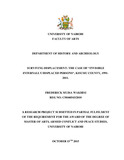| dc.description.abstract | The research set out to establish the existence of “invisible IDPs” in Kisumu County, investigate their challenges and specify coping mechanisms.
„Invisible IDPs‟ are displaced persons who were absorbed by their original communities‟ eeking a living. Like fellow displaced in camps, they lost sources of livelihood, security, belongings and sense of belonging. Their experiences, coping mechanisms to myriad challenges have gone unrecorded. Scholars have so far concentrated in research on IDPs in the camp range, not on these “invisible IDPs”. This is the gap in our knowledge which constitutes the research problem of this study.
Self-Efficacy Theory of Albert Bendura informed the Theoretical framework of the Research study. The study was based on two hypotheses; „the longer IDPs had stayed away from ancestral homes made it difficult for them to be accepted by kin and kith‟ and „invisible IDPs‟ face similar challenges like IDPs in camps.‟
This is a case study by design, qualitative in nature. The research is a descriptive analysis of election related violence and IDP consequence of conflict. The study used both primary and secondary sources of data. The tools used for data collection included; camera and tape recorder. The researcher used purposive sampling method with snowballing effect.
At the re-introduction of pluralism, politically engineered election related violence caused displacement in Kisumu County, spanning from 1991 to 2011.
The displaced faced various challenges; loss of livelihood, loss of loved ones, family breakdown, trauma, cultural dysfunction, security, translocation, disruption of education, destitution and ethnic polarization among others.
These displaced adopted numerous coping mechanisms in surviving displacement, they include; petty farming/fishing, social capital/kin and kith, family separations, religion, sports, entrepreneur, child labour, self-help groups among others.
The project makes two types of recommendations; academic and policy. | en_US |

